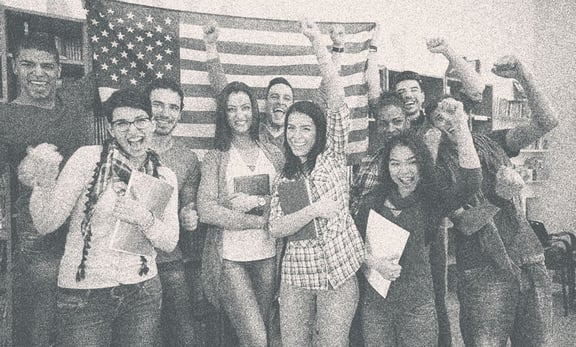When you finally make it into your dream program, one of the questions will be, “how you can work as a student in the US?”
International students have some conditions and restrictions for working on and off campus. As always, individual cases and visa types are significant to have a work permit as a student.
In this article, we will discuss the F-1 non-immigrant student visa. In addition, we will give you the details of the work permits you will have while holding an F-1 visa.
Check out other student visa opportunities by reading our article “Student Visa Options in the US: F1, M1, J1“
What is an F-1 visa?
When you decide to come to the US to study, there are several types of visas: F-1, M-1, and J-1. Each of them has different conditions and rules for visa holders. For example, while an F-1 visa is for academic purposes, an M-1 visa is for students traveling to the US for vocational studies. Lastly, a J-1 visa is for exchange students and lecturers.
An F-1 visa is a non-immigrant student visa granted to people who want to study in the USA. It is the most popular visa option for full-time students. Besides, F-1 visa holders have the opportunity to bring their immediate family with them to the US. This means that the candidate’s spouse and children (unmarried and under 21 years old) can apply for an F-2 visa which allows them to travel with the F1 visa holder.
How to apply for an F-1 Visa?
The F-1 visa application process can be both exciting and nerve-wracking. It is a significant step towards achieving your academic and career goals. After all, studying in the United States is an exhilarating opportunity. However, the process can also be overwhelming, as it involves a lot of paperwork, fees, and a visa interview that can feel stressful.
Many students may feel anxious about whether their visa application will be approved, especially if they are leaving behind their home country and loved ones. But, with careful preparation and guidance, most students can successfully navigate the process and start their academic journey in the United States.
Here is a brief list of the application requirements for the F-1 visa:
– The applicant must prove they can cover their educational and living expenses during their studies.
– The applicant must prove that they will return to their home country after completing their studies and that they have strong social and economic ties in their home country.
– The applicant must have an acceptance letter and Form I-20 (Certificate of Eligibility for Non-immigrant Student Status) from an educational institution in the USA.
F-1 Visa and Work Opportunities
Students who come to the US on an F-1 visa have the opportunity to work under certain conditions. However, as for their immediate families, F-2 visa holders are not allowed to work.
F-1 students are allowed to work in the United States, but only under certain conditions and in accordance with complex guidelines and restrictions issued by the United States Citizenship and Immigration Service (USCIS).
Areas that F-1 students can work are as follows:
– On-campus employment
– Off-campus employment
– Working Due to Economic Difficulties
– OPT (optional practical training)
– CPT (practical training within the curriculum)
– STEM OPT
*Form I-20 Certificate of Eligibility for Non-immigrant Student Status: Form I-20 is the most important document prepared by the school for students studying at an educational institution in the USA and is the essential document of the visa process and your residence in the USA afterward. For the form to be prepared, you must show that you can afford the school’s educational expenses. Therefore, the form is a document that proves your education and financial status in the US.
What is On-Campus Employment?
USCIS places few conditions on on-campus employment for students with F-1 visas, allowing them to work according to the opportunities their universities offer. However, although F-1 status includes on-campus employment privilege, on-campus job opportunities are minimal at most schools.
Unlike the general requirements, you must not complete and certify Form I-765 (Application for Employment Authorization) to work on campus. During the school year, you can work up to 20 hours per week on campus, while during break periods, your work authorization can be up to 40 hours per week.
Even if you find a job on campus, you may need more than the wages you earn to cover your financial needs. In addition, many schools require you to obtain permission from the International Student Office before accepting any work on campus. Sometimes, the school may not allow students to work on campus during their first semester or year.
Since your situation is always dependent on the support of your school, you should seek guidance and permission from your International Student Office before applying for or accepting any work and request their comments on any ambiguous situation. You will also need advice from your school to ensure that you have reported all the appropriate forms to USCIS and obtained your necessary approvals.
Finally, not every job physically located on campus may be considered “on-campus employment.” For example, even if a construction company continues to operate on campus, it is unlikely that the job you might find there would be considered “on-campus employment.”
Here are questions that can help you with this:
– Is the position located on the campus of your home university (the campus in the city where the I-20 is registered)?
– Do you receive your salary from your home university?
– Does the employment provide direct services to your home university?
– Is the work a contract-funded research project at the graduate level?
If you answered yes to the above questions, your job is considered to be located on campus.
If your answers to the above questions have made you concerned that your work is not on campus, you should apply for the appropriate off-campus authorization for your visa type.
What is Off-Campus Employment?
Off-campus employment is any employment that is not on the USC campus. It is possible to find off-campus work while you are a student, but it can be difficult and time-consuming.
There are a few different types of employment authorization available to F-1 students for off-campus employment: CPT (Curricular Practical Training), OPT (Optional Practical Training), and STEM OPT.
Working Due to Economic Difficulties
When issuing the F-1 visa, USCIS assumes that you will be able to meet your financial needs and will not need off-campus work authorization. However, you may be granted permission to work off-campus if you can prove that you are experiencing economic hardship due to emergencies, such as unforeseen events after you enrolled in college (the unpredictable exchange rate in your country), health problems, or family issues.
Your challenging economic circumstances, the loss of your on-campus job, and your need for financial support qualify for an exception to allow students in F-1 status to work off-campus.
At least one year of study as a student and good grades play a crucial role in applying for off-campus employment. You can apply for work authorization at USCIS by completing form I-765. Even if USCIS approves your off-campus employment, it will still be limited to 20 hours per week. Your field of employment does not need to be related to your field of study.
CPT (Curricular Practical Training)
Another job you can do with your F-1 visa is curricular practical training or CPT. Unlike on-campus employment, CPT does not have a 20-hour limit. However, it has to be work related to your field of study. The purpose of CPT is to give you supervision about your field of study. This is why you can also find off-campus employment.
You do not have to complete and submit Form I-765 (Application for Employment Authorization) to apply for CPT.
However, you should receive a CPT authorization letter from your school. This document must show that the internship or work you will be doing is within the curriculum. Your school needs to submit this CPT authorization so that SEVIS (Student and Exchange Visitor Program) is aware of the student’s activities and can maintain the F-1 visa status.
OPT (Optional Practical Training)
Another opportunity for off-campus employment is optional practical training (OPT). This program is the right to work in the field in which the student is studying. Students who have completed at least nine months of their degree (undergraduate, graduate, etc.) are entitled to 12 months of OPT during and after their studies. However, a student who has completed the CPT program cannot apply for the OPT program.
For example, a student who completes a 12-month full-time CPT program at the undergraduate level cannot apply for OPT. Likewise, a student who participated in an OPT program for a bachelor’s degree can only apply for OPT if they enroll in a bachelor’s program for a second time. However, when they finish their bachelor’s degree and start a master’s degree, they can apply for OPT again. Unlike the CPT program, when you apply for OPT, you must complete Form I-765 and have it approved by USCIS.
STEM OPT
Students with F-1 visa status who have completed a bachelor’s, master’s, or doctoral degree in government-designated STEM fields may apply to USCIS for an extension of the OPT program for up to 24 months if they have a job or job offer.
The earliest you can apply to extend your visa is 90 days before your OPT program ends. USCIS will consider your application for an OPT extension before the OPT program you are currently on ends.
To submit your application, complete the “Request for STEM OPT recommendation I-20” form online. Then you will need to submit your most recent I-94, your EAD, a hand-completed and signed Form I-983, and your most recent I-20. You must obtain a new I-20 from your school in the next step.
You can file your application with USCIS online or by mail. For more information, please visit the official page of USCIS.
Simplify Your Life in America with Grape Law
As a student in a new country, it will be essential for you to gain economic needs and work experience simultaneously. However, deciding how to proceed with your rights and visa requirements can take time and effort. At Grape Law, we are here to help you with your visa application and your new life possibilities. Contact us via info@grapelaw.com or schedule a face-to-face consultation on our website!
Categories







